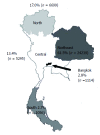Characteristics and outcomes of cholangiocarcinoma by region in Thailand: A nationwide study
- PMID: 29093624
- PMCID: PMC5656463
- DOI: 10.3748/wjg.v23.i39.7160
Characteristics and outcomes of cholangiocarcinoma by region in Thailand: A nationwide study
Abstract
Aim: To identify the potential risk factors of cholangiocarcinoma, we determined the characteristics of cholangiocarcinoma patients among 5 different regions of Thailand.
Methods: All patients diagnosed with cholangiocarcinoma between 2008 and 2013 were identified using the Nationwide Hospital Admission Data registry (n = 39421). Baseline characteristics, comorbidities and survival were abstracted.
Results: The annual incidence during the study period was stable in all regions. Most patients lived in the Northeast (62.8%), followed by the North (16.9%), Central (12.3%), Bangkok (5.4%), and South (n = 2.6%) regions (P < 0.0001). Significantly more cholangiocarcinoma patients had diabetes, cirrhosis, and chronic viral hepatitis B/C infection than non-cholangiocarcinoma participants (diabetes: 11.42% vs 5.28%; cirrhosis: 4.81% vs 0.92%; hepatitis B: 0.74% vs 0.12%; and hepatitis C: 0.50% vs 0.10%, P < 0.0001 for all, respectively). The overall 1-year mortality rate was 81.7%, with a stable trend over time.
Conclusion: Diabetes and chronic liver diseases may be associated with cholangiocarcinoma in the Thai population.
Keywords: Bile duct cancer; Epidemiology; Liver fluke infection; Population-based study.
Conflict of interest statement
Conflict-of-interest statement: The authors hereby declare no personal or professional conflicts of interest regarding any aspects of this study.
Figures
References
-
- Bragazzi MC, Cardinale V, Carpino G, Venere R, Semeraro R, Gentile R, Gaudio E, Alvaro D. Cholangiocarcinoma: Epidemiology and risk factors. Transl Gastrointest Cancer. 2012;1:21–32.
-
- Alvaro D, Crocetti E, Ferretti S, Bragazzi MC, Capocaccia R; AISF Cholangiocarcinoma committee. Descriptive epidemiology of cholangiocarcinoma in Italy. Dig Liver Dis. 2010;42:490–495. - PubMed
Publication types
MeSH terms
LinkOut - more resources
Full Text Sources
Other Literature Sources
Medical


